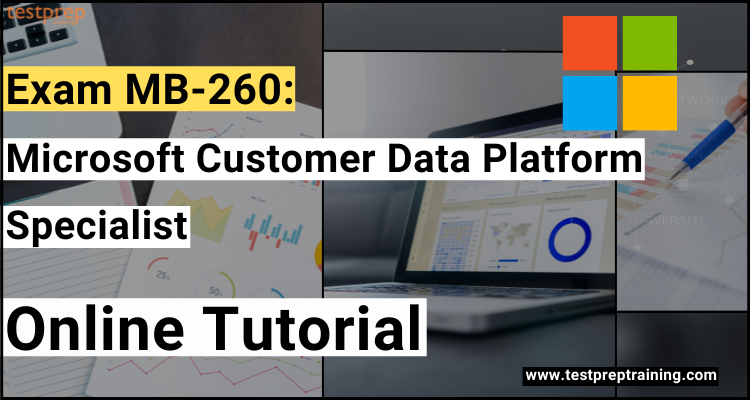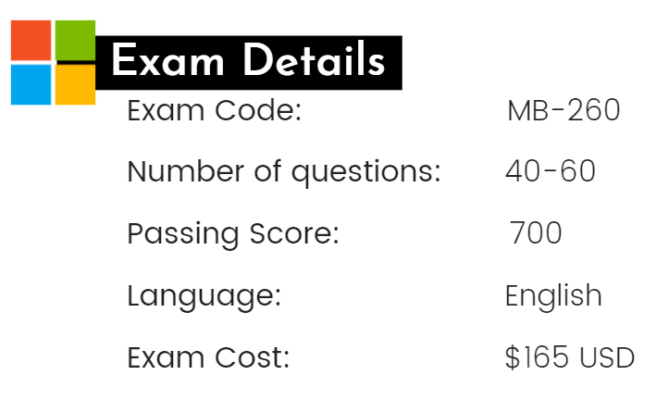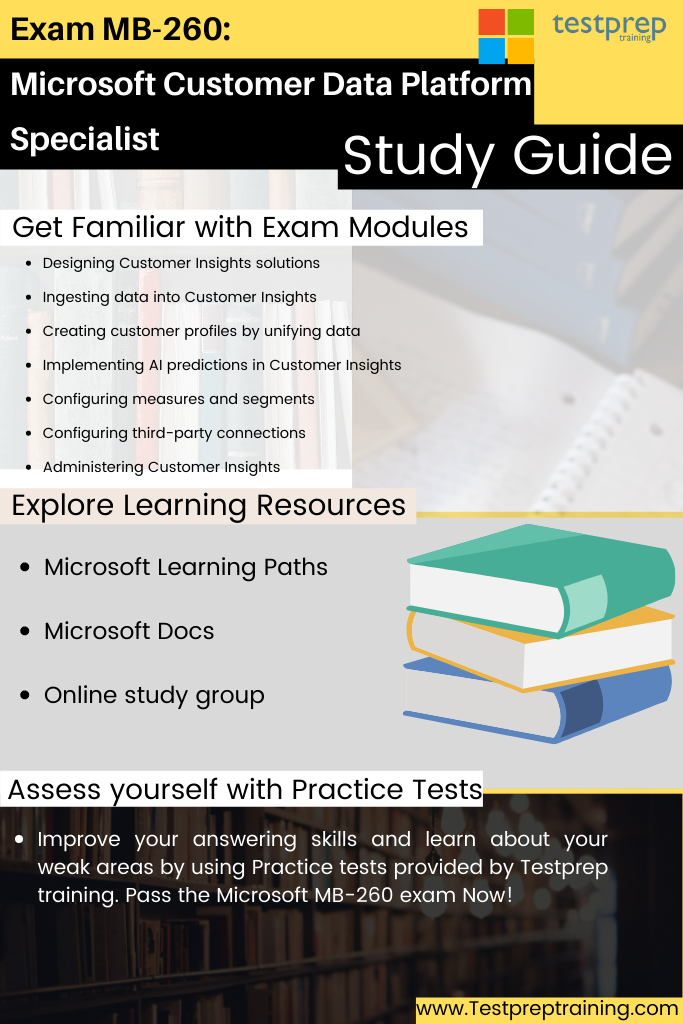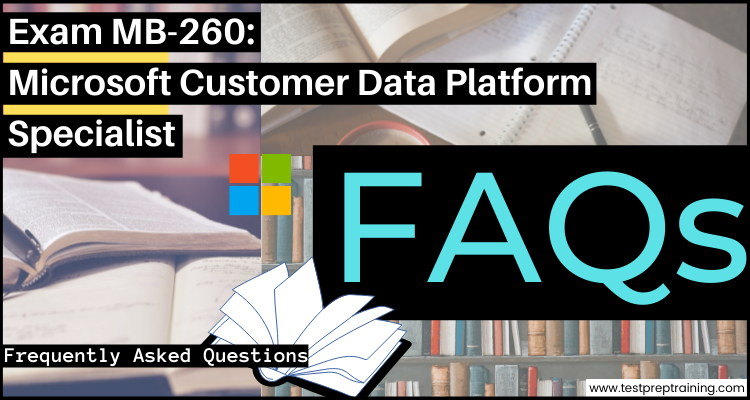Exam MB-260: Microsoft Customer Data Platform Specialist

Candidates who pass the MB-260: Microsoft Customer Data Platform Specialist exam will be able to develop solutions that provide insights into customer profiles and track engagement activities to improve customer experiences and retention.
Knowledge requirement:
- Candidates should have hands-on expertise with Dynamics 365 Customer Insights, Power Query, Microsoft Dataverse, Common Data Model, and Microsoft Power Platform, as well as one or more additional Dynamics 365 apps.
- Secondly, they should have first-hand familiarity with privacy, compliance, consent, security, responsible AI, and data retention policies.
- Thirdly, candidates must have prior expertise with KPIs, data retention, validation, visualisation, preparation, matching, fragmentation, segmentation, and enhancement procedures.
- Lastly, they should be familiar with Azure Machine Learning, Azure Synapse Analytics, and Azure Data Factory in general.
Microsoft MB-260 Exam Details

- There are 40-60 questions in the Microsoft MB-260 exam.
- Scenario-based single-answer questions, multiple-choice questions, arrange in the right order type questions, drag & drop questions, and mark review, drag, and drop type questions are all examples of exam questions.
- A candidate must, however, get a score of 700 or better in order to pass the exam. Furthermore, the Microsoft MB-260 exam is only offered in English and costs $165 USD.
Microsoft MB-260 Exam Course Outline
To assist in better preparation for the MB-260 exam, Microsoft provides a course outline that covers the important components. This includes the following:
1. Design Dynamics 365 Customer Insights – Data solutions (5–10%)
Describe Customer Insights – Data
- Describe Dynamics 365 Customer Insights – Data components, including tables, relationships, enrichments, activities, measures, and segments (Microsoft Documentation: Define and manage measures)
- Describe the first run experience (FRE) in D365 Customer Insights – Data
- describe support for near real-time updates (Microsoft Documentation: Real-time processing)
- describing support for enrichment (Microsoft Documentation: Enrich customer profiles with affinities and share of voice)
- Describe the differences between individual consumer and business account profiles.
Describe use cases for Customer Insights – Data
- Describe use cases for Dynamics 365 Customer Insights – Data (Microsoft Documentation: Audience insights for Dynamics 365 Customer Insights)
- Describe use cases for extending Customer Insights – Data by using Microsoft Power Platform components (Microsoft Documentation: Extending Customer Insights with Power Platform)
- Describe use cases for Customer Insights – Data APIs (Microsoft Documentation: Work with Customer Insights APIs)
- Describe use cases for working with business accounts
2. Ingest data into Customer Insights – Data (10–15%)
Connect to data sources
- determine which data sources to use
- determine whether to use the managed data lake or an organization’s data lake (Microsoft Documentation: Best practices for using Azure Data Lake Storage Gen2)
- Attach to Microsoft Dataverse data lake
- Attach to Azure Data Lake Storage
- Ingest and transform data using Power Query connectors
- Attach to Azure Synapse Analytics
- describe real-time ingestion capabilities and limitations (Microsoft Documentation: Azure Data Explorer data ingestion overview)
- describe benefits of pre-unification data enrichment (Microsoft Documentation: Data enrichment)
- Ingest data in real-time
- Update Unified Customer Profile fields in real-time
- Understand common ingestion errors
Transform, cleanse, and load data by using Power Query
- select tables and columns (Microsoft Documentation: Tables)
- resolve data inconsistencies, unexpected or null values, and data quality issues (Microsoft Documentation: Clean, transform, and load data in Power BI)
- evaluate and transform column data types (Microsoft Documentation: Data types in Power BI Desktop)
Configure incremental refreshes for data sources
- identify data sources that support incremental updates (Microsoft Documentation: Incremental refresh for datasets)
- Configure incremental refresh
- identify capabilities and limitations for scheduled refreshes (Microsoft Documentation: Data refresh in Power BI)
- configure scheduled refreshes and on-demand refreshes (Microsoft Documentation: Data refresh in Power BI)
3. Create customer profiles through data unification (30-35%)
Select source fields
- Select Customer Insights tables and attributes for unification
- select attribute types (Microsoft Documentation: Manage attributes and attribute groups)
- select the primary key
Remove duplicate records
- Deduplicate enriched tables
- Define deduplication rules
- Review deduplication results
Match conditions
- Specify a match order for tables
- Define match rules
- Define exceptions
- Include enriched tables in matching
- Configure normalization options
- Differentiate between basic and custom precision methods
Unify customer fields
- Specify the order of fields for merged tables
- Combine fields into a merged field
- Combine a group of fields
- Separate fields from a merged field
- Exclude fields from a merge
- Change the order of fields
- Rename fields
- Group profiles into Clusters
Implement business data separation
- Understand business unit separation prerequisites
- Access business data in Dataverse
- Implement Customer Insights – Data business unit integrations
Review data unification
- Review and create customer profiles
- View the results of data unification
- Verify output tables from data unification
- Update the unification settings
Configure relationships and activities
- create and manage relationships (Microsoft Documentation: Create and manage relationships in Power BI Desktop)
- create activities by using a new or existing relationship (Microsoft Documentation: Table relationships)
- Create activities in real-time
- manage activities (Microsoft Documentation: Track and manage activities)
- Combine customer profiles with activity data from unknown users
- Display Customer Insights – Data Activities in D365 Activity Timeline
Create a unified contact profile for B2B accounts
- Create unified contact profile
- Set the relationship between contacts and accounts
- Define the semantic fields
- Review contact unification
- Verify output tables from data unification
Configure search and filter indexes
- Define which fields should be searchable
- Define filter options for fields
- Define indexes
4. Implement AI predictions in Customer Insights – Data (5–10%)
Use Copilot in Customer Insights – Data
- Understand key Discovery page components
Configure prediction models
- configure and evaluate the customer churn models, including the transactional churn and subscription churn models (Microsoft Documentation: Transactional churn prediction)
- configuring and evaluating the product recommendation model (Microsoft Documentation: Product recommendations overview)
- configure and evaluate the customer lifetime value model (Microsoft Documentation: Customer lifetime value (CLV) prediction)
- create a customer segment based on a prediction model (Microsoft Documentation: Create a segment based on a prediction model)
- Configure and manage sentiment analysis
Implement machine learning models
- describe prerequisites for using custom Azure Machine Learning models in Customer Insights – Data (Microsoft Documentation: Custom machine learning models)
- Use a wizard to bring custom prediction models to Customer Insights – Data
- implement workflows that consume machine learning models (Microsoft Documentation: Deploy machine learning models to Azure)
- manage workflows for custom machine learning models (Microsoft Documentation: Custom machine learning models)
5. Configure measures and segments (10–15%)
Create and manage measures
- Create and manage tags
- describe the different types of measures (Microsoft Documentation: Create measures for data analysis in Power BI Desktop)
- create a measure (Microsoft Documentation: Create Measures)
- create a measure by using a template (Microsoft Documentation: Define and manage measures)
- configure measure calculations (Microsoft Documentation: Create measures for data analysis in Power BI Desktop)
- modify dimensions (Microsoft Documentation: Modify or Delete a Database Dimension in Solution Explorer)
- Schedule Measures
Create and manage segments
- Create and manage tags
- Describe methods for creating segments, including segment builder and quick segments (Microsoft Documentation: Working with segments)
- create a segment from customer profiles, measures, or AI predictions (Microsoft Documentation: Suggested segments)
- Create a segment based on a prediction model
- Find similar customers (Microsoft Documentation: Similar Customers)
- Project attributes
- Track usage of segments
- Export segments
Find suggested segments
- describe how the system suggests segments for use (Microsoft Documentation: Segments overview)
- create a segment from a suggestion (Microsoft Documentation: Suggested segments based on activity data)
- Create a suggested segment based on activity
- configure refreshes for suggestions (Microsoft Documentation:
Create segment insights
- configure overlap segments (Microsoft Documentation: Segment insights)
- configure differentiated segments (Microsoft Documentation: Customer segmentation and targeting)
- analyze insights (Microsoft Documentation: Application Insights)
- Find similar segments with AI
6. Configure third-party connections (10–15%)
Configure connections and exports
- configuring a connection for exporting data (Microsoft Documentation: Data export service)
- create a data export (Microsoft Documentation: Export case data in eDiscovery)
- define types of exports (Microsoft Documentation: Exports)
- configure on demand and scheduled data exports (Microsoft Documentation: Exports)
- define the limitations of segment exports
Export data to Dynamics 365 Customer Insights – Journeys or Dynamics 365 Sales
- identify prerequisites for exporting data from Customer Insights – Data (Microsoft Documentation: Overview of Exports)
- Create connections between Dynamics 365 Customer Insights – Data and Dynamics 365 apps (Microsoft Documentation: Product overview for Dynamics 365 Customer Insights)
- define which segments to export (Microsoft Documentation: Overview of Exports)
- Export a Dynamics 365 Customer Insights – Data segment into Dynamics 365 Customer Insights – Journeys as a marketing segment (Microsoft Documentation: Use segments from Dynamics 365 Customer Insights with Dynamics 365 Marketing)
- Use Dynamics 365 Customer Insights – Data profiles and segments with real-time marketing
- Export a Dynamics 365 Customer Insights – Data profile into Dynamics 365 Customer Insights – Journeys for customer journey orchestration (Microsoft Documentation: Use segments in Dynamics 365 Marketing)
- Export a Dynamics 365 Customer Insights – Data segment into Dynamics 365 Sales as a marketing list (Microsoft Documentation: Export segments to Dynamics 365 Sales)
- Display Customer Insights – Data data from within Dynamics 365 apps
Identify what data from Dynamics 365 Customer Insights – Data can be displayed within Dynamics 365 apps Configure the Customer Card add-in for Dynamics 365 apps - Identify permissions required to implement the Customer Card Add-in for Dynamics 365 apps
Implement Data Enrichment
- enrich customer profiles (Microsoft Documentation: enrich customer profiles)
- configure and manage enrichments (Microsoft Documentation: Data enrichment)
- enrich data sources before unification (Microsoft Documentation: Enrichment for data sources)
- View enrichment results
Use Customer Consent data
- Add Consent Data to Customer Insights – Data
- use consent data (Microsoft Documentation: Configure how users consent to applications)
Use Customer Insights – Data data across Power Platform and M365 applications
- Use D365 Customer Insights – Data chatbot for Microsoft Teams
- Connect Power Apps and Dynamics 365 Customer Insights – Data
- Use the Power Automate Connector for Dynamics 365 Customer Insights – Data
- Configure the Dynamics 365 Customer Insights connector for Power BI – Data
7. Administer Customer Insights – Data (5–10%)
Create and configure environments
- identify who can create environments (Microsoft Documentation: Create and manage environments in the Power Platform admin center)
- differentiate trial and production environments (Microsoft Documentation: Environments overview)
- Connect Customer Insights – Data to Microsoft Dataverse
- Connect Customer Insights – Data with Azure Data Lake Storage Account Manage existing environments
- Change or claim ownership of the environment
- Reset an existing environment
- Delete an existing environment
- configure user permissions (Microsoft Documentation: default user permissions in Azure Active Directory)
- describe available user permissions (Microsoft Documentation: Assign user permissions)
Manage system refreshes
- differentiate between system refreshes and data source refreshes (Microsoft Documentation: Refresh database)
- describe refresh policies (Microsoft Documentation: Overview of the Office cloud policy service for Microsoft 365 Apps for enterprise)
- configure a system refresh schedule (Microsoft Documentation: Configure update settings for Microsoft 365 Apps)
- monitor and troubleshoot refreshes (Microsoft Documentation: Performance troubleshooting plan for Office 365)
- Export diagnostic logs
Manage system refreshes
- Differentiate between system refreshes and data source refreshes
- Describe refresh policies
- Configure a system refresh schedule
- Monitor and troubleshoot refreshes
Create and manage connections
- describe when connections are used (Microsoft Documentation: Connections)
- configure and manage connections
For more: Check Microsoft MB-260 exam FAQs
Exam Policies
All exam facts and information, as well as exam-giving techniques, are contained in the Microsoft Certification Exam policies. According to these exam policies, certain rules must be followed during exam time or at testing sites. Some of them are:
Exam retake policy
According to this policy, candidates who fail the test for the first time must wait 24 hours before retaking it. During this time, they can reschedule the exam on the certification dashboard. They may be asked to wait at least 14 days before taking the exam again if this happens a second time. A 14-day waiting period is required between the third and fourth tries, as well as the fourth and fifth attempts. Candidates, on the other hand, are limited to five attempts each year. In addition, the 12-month period begins with the first attempt.
Exam reschedule and the cancellation policy
Microsoft will temporarily waive the reschedule and cancellation costs if candidates cancel their examinations within 24 hours of the scheduled appointment. There will be no fee if you reschedule or cancel an appointment at least 6 working days in advance. If a candidate cancels or reschedules a test within 5 business days of the planned exam time, a fee will be levied. Finally, if a candidate does not show up for an exam appointment or does not reschedule within 24 hours, the whole exam fee is forfeited.
Microsoft MB-260 Exam Study Guide

Exam objectives
In order to gain a good start on the Microsoft MB-260 exam preparation, candidates must be familiar with the exam objectives. The Microsoft MB-260 exam objectives contain important topics that will help you comprehend the key sections. Examine the study guide to have a better understanding of the topics and to boost your preparation.
- Designing Customer Insights solutions
- Ingesting data into Customer Insights
- Creating customer profiles by unifying data
- Implementing AI predictions in Customer Insights
- Configuring measures and segments
- Configuring third-party connections
- Administering Customer Insights
Microsoft Learning Platform
Microsoft gives you access to learning platforms with a variety of tools to help you prepare for your exams. Visit the Microsoft official website to discover everything you need to know about the Microsoft MB-260 exam and to prepare for it. Candidates will also gain in terms of better studying subjects and passing the test as a result of this.
Microsoft Docs
The Microsoft documentation is a knowledge source that provides in-depth information on the test subjects covered in the Microsoft MB-260 exam. You may also reference Microsoft documentation to learn about the various scales of different Azure services. This is comprised of courses that will assist you in learning a great deal about the numerous services and ideas included in the test.
Online Study Groups
When it comes to studying for tests, candidates might benefit from online study groups. In other words, joining study groups will keep you in touch with experts and professionals who are already on this route. You may also use this group to discuss your test-related query or concern, as well as to study for the Microsoft MB-260 exam.
Practice Tests
Taking practice exams is important for enhancing your preparation. By assessing yourself with Microsoft MB-260 practice exams, you will discover your weak and strong areas. Additionally, you will be able to enhance your response abilities, allowing you to save substantial time during the exam. After finishing a whole subject, taking the Microsoft MB-260 exam practice tests is the best way to progress. This will also aid in successful revision. So, to prepare for the Microsoft MB-260 exam, go online and look for the best practice exam tests.


